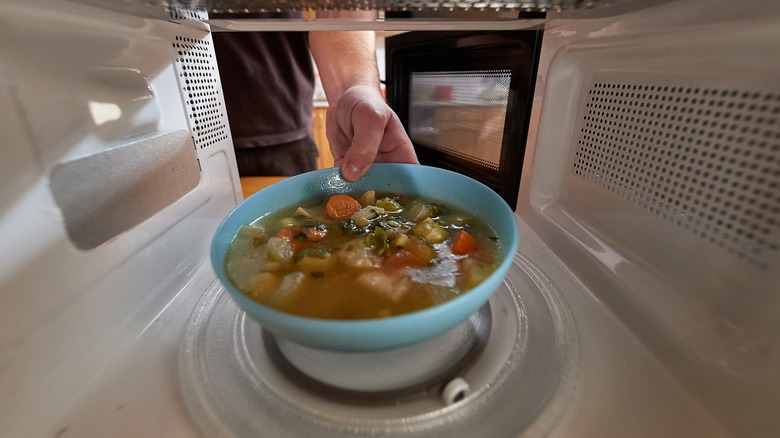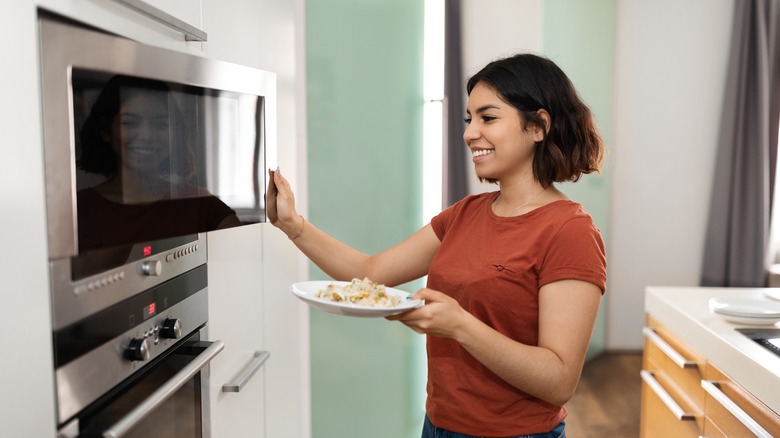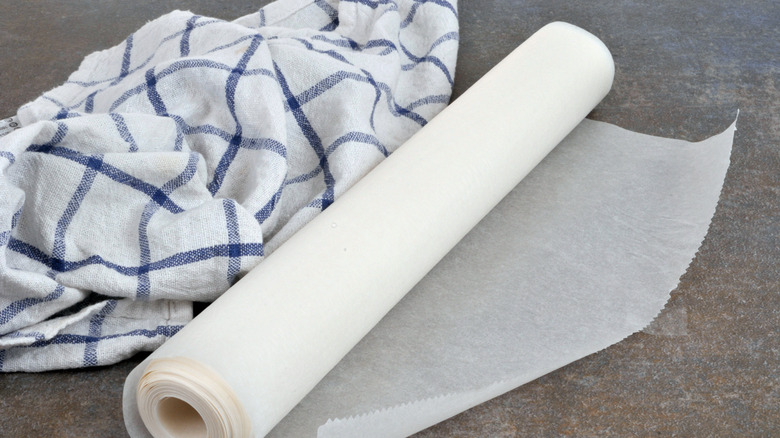The Little-Known Wax Paper Trick That Will Keep Your Microwave Sparkling Clean
Ovens, refrigerators, microwaves: these kitchen appliances make life incredibly convenient — until they don't. Having to clean out useful machines like your microwave can be one of those tasks you'd like to avoid at all costs, so stuck-on food can sometimes stay stuck for far longer than it should. After all, who really looks inside the microwave except those people that live under your roof? Eventually, however, it has to be cleaned. Wouldn't it be nice if there was a trick to keep food from splattering in the first place? Fortunately, there is. Look no further than that roll of wax paper sitting in your kitchen drawers or pantry. By placing a piece of this coated wrapping over a plate, bowl, or cup before you turn on the microwave, you can repurpose the wax paper to keep spills from dirtying your appliance any time you use it!
Wax paper can come in handy for a lot of kitchen tasks including when wrapping things like sandwiches to keep them from drying out, reducing your ingredients' exposure to the air, and wrapping up freezer foods to preserve them better. However, besides these strictly food-related benefits, wax paper is also beneficial for cleaning tasks as well. For instance, some people put wax paper on top of their fridge to make dusting the area easier. Further, by placing a small piece of this material over your container before you turn on the microwave, you can also save your appliance from mess, thereby saving you time and energy, too.
No muss, no fuss
Using wax paper as a food cover might make it one of the most valuable items in your kitchen cabinets. To save your microwave's interior from splatters, spills, and stains, place your food (solid or liquid) on a microwave-safe dish, then take a sheet of wax paper and cover the top of your plate, bowl, or cup completely. To help the paper stay in place, you can either fold it securely around the edges of your dishware or pull off enough to secure it underneath your vessel. The microwave fans inside the appliance could blow the sheet off, which is why tucking it underneath the dish is a good option. Heat up your food as normal, then remove the paper and save it to use again (so long as it's not covered in sauce, grease, or other leftovers from your meal).
Wax paper is coated in paraffin wax that produces a non-stick lining, so it's easy to rinse off. This non-stick characteristic also makes it great for putting inside the fridge for easy clean-up. Further, because the paper is safe to use in the microwave (per the USDA), you can place food on or under it and the wax won't transfer to your meal even when heated. The wax paper will act like a lid, keeping in anything that would otherwise splatter inside the appliance. If your food didn't dirty the paper, it can easily be reused until you decide that a new piece is necessary.
Wax paper is the safer choice, too
Not only will your microwave stay cleaner, but the wax paper will also help keep the heat inside the dish as your items cook, allowing for faster results so you can enjoy a fully-warmed meal in seconds. Add a wax paper lid to everything from chicken and roasts to rice, soups, hot drinks, and pasta when you pop them into the microwave. Furthermore, a strip of this material is actually safer to use in your appliance than some plastic lids, since the latter can contain chemicals that aren't healthy, and you likely don't want to transfer these to your food. Paraffin wax is safe to ingest should it come into contact with your microwaved meals, which makes heating your items with this paper a better overall option.
At the same time, it's important to remember that wax paper isn't meant to be used in extremely high temperatures. This shouldn't be a concern in the microwave, as this appliance doesn't heat food up to over 212 degrees Fahrenheit. However, keep in mind that using it in the oven could be dangerous and cause it to melt, as temperatures can get much higher in this appliance. Therefore, use parchment paper instead in the oven, which can withstand temperatures of up to 450 degrees Fahrenheit.


